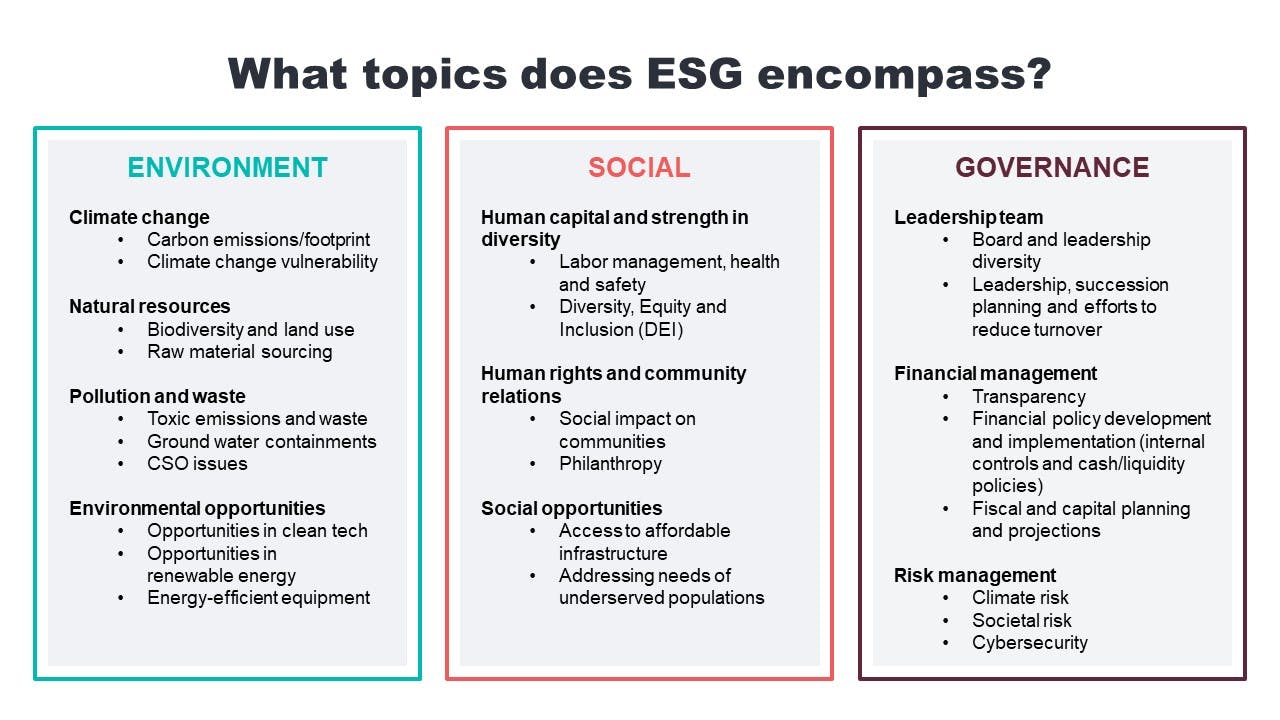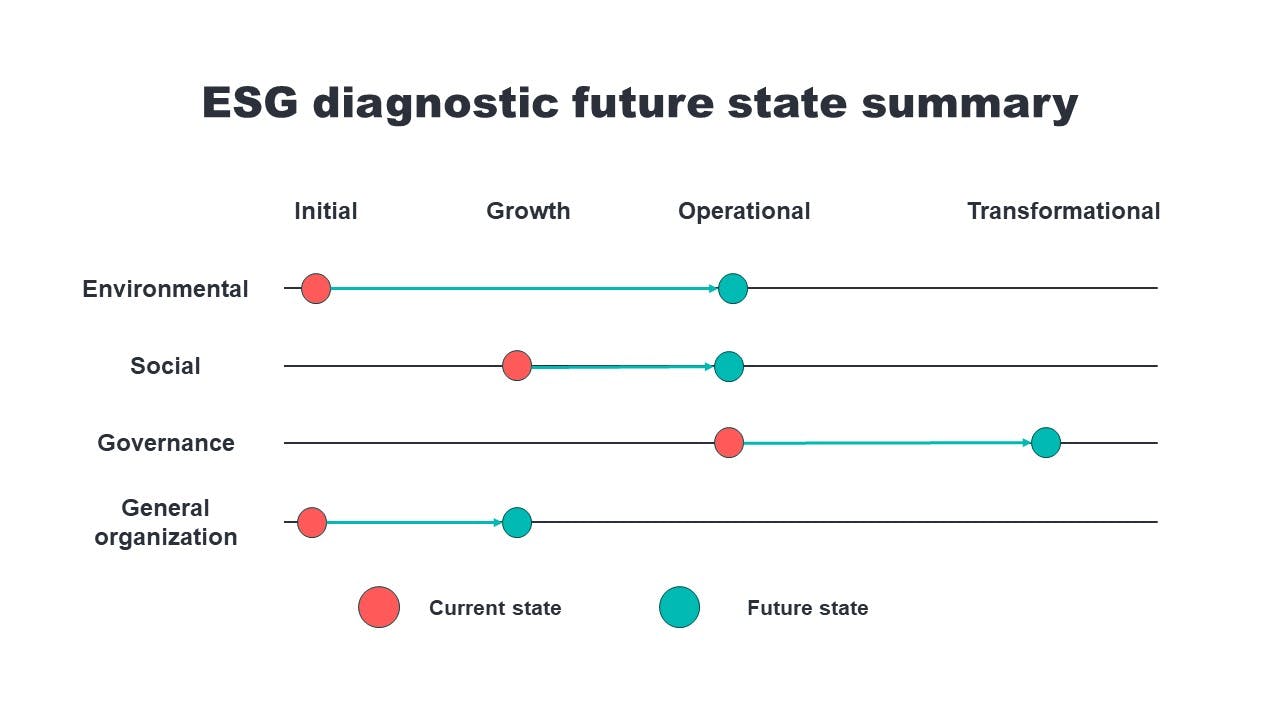
Introducing the ESG Diagnostic: Navigating the path to resiliency and sustainability
What does ESG mean for the public sector?
In the ever-evolving landscape of public sector priorities, where challenges such as affordable housing, infrastructure resiliency, social equity, and government transparency take center stage, the Environmental, Social, and Governance (ESG) movement has gained significant influence. Its influence is continuing to gain momentum in the United States, holding the potential to reshape how our cities and communities address critical issues. Furthermore, ESG principles are intertwined into almost every facet of government operations, as outlined in the graphic below.
The significance of embracing ESG principles becomes apparent when considering the following compelling factors:
- Serving vulnerable populations: A 2021 study by Boston University underscored the challenge faced by mayors, with only 1 in 5 feeling they have “more than moderate” control over homelessness within their cities. And government leaders are further tasked with addressing the root causes of homelessness with both innovative and effective solutions.
- Competition for talent: Recruitment and retention of a qualified workforce continues to plague public sector leaders with the largest numbers of vacancies in public health, public safety and engineering and skilled trades. Attracting the Gen Z workforce is paramount in filling those gaps. 90% of this generation believes companies should actively contribute to social and environmental causes. Moreover, 83% of Gen Z consider a company's purpose when making career decisions. *
- Changes in population: Ongoing shifts in population patterns can disrupt regional fiscal and political dynamics. Strategic efforts to retain and attract citizens while planning for responsible growth are imperative for local governments and their private and non-profit partners.
- Funding opportunities: Federal initiatives like Justice 40 and private sector regulation like the SEC-mandated climate disclosures are poised to channel federal grants and private investments toward public sector entities aligned with ESG principles. Organizations showcasing alignment with climate resilience, social equity and effective governance stand to attract the most substantial investments. Showing these alignments in conjunction with capital borrowings can occur through the use of designations, more risk and project disclosures, or an investor-focused resiliency and sustainability report.
By centering strategic endeavors and resources around ESG, public sector organizations can position themselves to access new funding sources, welcome fresh talent, and address pressing social issues such as affordable housing and equitable economic development.
What does ESG mean for our public sector leaders?
Public sector leaders, often tasked with multifaceted responsibilities, serve as architects of resilience both within their organizations and communities. These leaders operate based on an array of "blueprints," including strategic plans, long-range financial forecasts, climate action plans, and more. However, the execution of these plans often occurs within different layers or silos of the organization, posing challenges for aligning activities and strategies with ESG principles. Consequently, articulating the ESG narrative to citizens, private industry, funders, and stakeholders becomes an intricate endeavor.
What is an ESG Diagnostic and how can it help?
To empower public sector organizations in comprehending their existing ESG-related landscape, Baker Tilly developed the ESG Diagnostic tool. This tool offers an initial entry point into the ESG discourse, requiring manageable effort to initiate and the guidance of a Baker Tilly expert throughout the process. The bullets below illustrate the typical ESG diagnostic journey:
1. Project kickoff and training: A collaborative session between project steering committee members and Baker Tilly, focusing on project objectives, tool usage, and ESG fundamentals.
2. Scoring and assessment: Each steering committee member individually evaluates key programs and activities aligned with ESG principles. Scores reflect the organization's maturity in various areas, offering insights into strengths and growth opportunities.
3. Aggregation and analysis: A Baker Tilly professional consolidates scores, highlighting areas of discrepancy and potential consensus-building opportunities.
4. Strategic discussion: The steering committee and Baker Tilly convene to deliberate on compiled results, resolve score disparities, and identify priority areas for further action. This phase often leads to the comprehensive documentation of an ESG plan, linking existing initiatives to ESG principles and defining new objectives for advancement.
The ESG Diagnostic serves as a navigational tool, guiding public sector entities towards resiliency and sustainability. By harmonizing efforts with ESG ideals, these organizations can unlock funding avenues, attract top-tier talent, and foster holistic societal development. As the landscape of public priorities continues to evolve, embracing ESG principles stands as a pivotal step towards building resilient and thriving communities.
*https://www.accenture.com/us-en/insights/sustainability/sustainable-organization
Sample ESG Diagnostic with limited review criteria:
| ESG Diagnostic |
| General organization |
Scoring criteria: Business strategy alignment Data and technology: Initial Goal setting and accountability: Initial Oversight, processes and policies: Initial Reporting, communication and transparency: Initial Sub category maturity: Initial Rationale / Explanation: Elements of ESG principles can be found throughout organizational planning and budgeting documents but there is no comprehensive ESG strategy or alignment of ESG programs with organization-wide strategic initiatives. |
| Environmental |
Scoring criteria: Climate change vulnerability Data and technology: Initial Goal setting and accountability: Initial Oversight, processes and policies: Initial Reporting, communication and transparency: Initial Sub category maturity: Initial Rationale / Explanation: Currently engaged with a consultant to begin work on a climate action plan. |
| Social |
Scoring criteria: Employee engagement and development Data and technology: Initial Goal setting and accountability: Operational Oversight, processes and policies: Operational Reporting, communication and transparency: Operational Sub category maturity: Operational Rationale / Explanation: The organization has a robust employee engagement program, defined career pathways and a mentoring and coaching program in place to develop employee soft skills and readiness for leadership. Tracking and management of programs is manual and not tied to other organizational technology. |
Scoring criteria: Community relations and social impact on communities Data and technology: Initial Goal setting and accountability: Growth Oversight, processes and policies: Growth Reporting, communication and transparency: Initial Sub category maturity: Growth Rationale / Explanation: Legacy community engagement activities are in place and managed within the community and economic development department. Reporting on feedback received and transparency on how it is incorporated into organizational budget and strategy is informally communicated to stakeholders. A strategic initiative of the department is to review current processes and find avenues for broader input and more transparent reporting. |
| Governance |
Scoring criteria: Financial policy development and implementation (internal controls, etc.) Data and technology: Operational Goal setting and accountability: Operational Oversight, processes and policies: Operational Reporting, communication and transparency: Operational Sub category maturity: Operational Rationale / Explanation: Financial oversight, controls and supporting technology are aligned with best practice and embedded in the standard workflows of the organization. |


